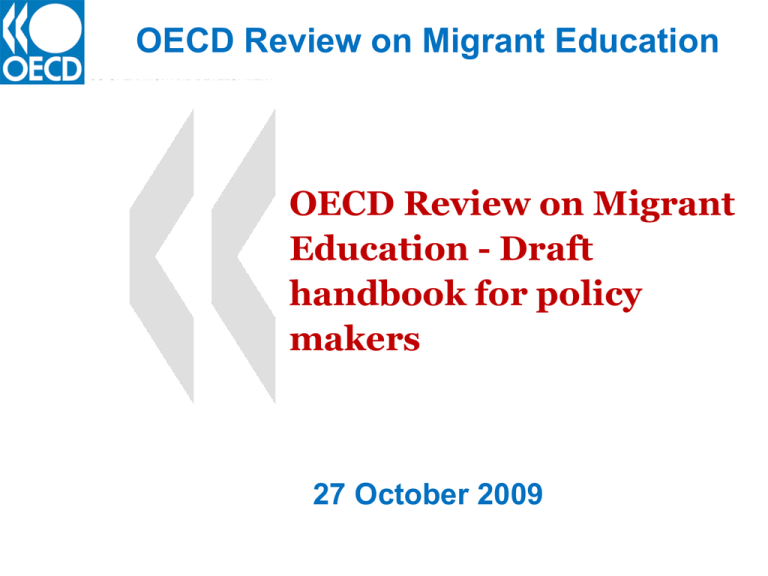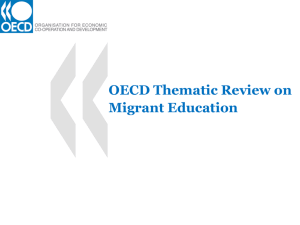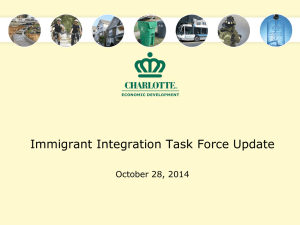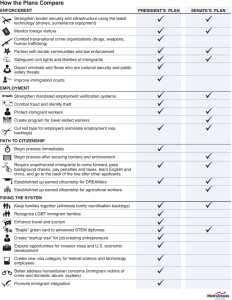OECD Review on Migrant Education - Draft handbook for policy makers
advertisement

OECD Review on Migrant Education OECD Review on Migrant Education - Draft handbook for policy makers 27 October 2009 History and economic factors affecting migrant education policy • Common pattern: increasing & more mixed migration • The effect of the crisis on the pattern and implications for migrant education • Changing immigration policies • Other contextual factors affecting migrant education Education outcomes: evidence and policy implication • Facts about education outcomes of immigrant students - performance, participation, and access to quality education • Major factors linked to education outcomes • Policy implication Performance – secondary education • marked performance differences in reading between native and immigrant students at age 15 in many countries Score Native students Second-generation immigrant students First generation immigrant students OECD average performance in reading 600 550 500 450 400 Roughly equivalent to one year of schooling Performance – primary education • Differences in average reading performance in primary education (less pronounced than those of secondary education) Score 600 550 500 450 400 Native students Second-generation immigrant students First generation immigrant students International average • Immigrant students are an academically diverse group: both top performing and low performing immigrant students. BUT • A larger share of 1st-generation with very low reading skills than their native and 2nd-generation peers Native 500 450 Proficiency level 1 400 350 300 250 200 Second generation First generation Participation • 1st-generation immigrants are less likely to attend preschool compared to their native and 2nd-generation immigrant peers. Native students % 100 90 80 70 60 50 40 30 20 10 0 Second generation immigrant students First generation immigrant students • In some countries both native and immigrant students repeat a grade, while in other countries this practice is rare. BUT • Immigrant students are more likely to repeat a grade in primary or lower secondary education than native students. % 40 35 30 25 20 15 10 5 0 Native students (primary) Native students (secondary) Immigrant students (primary) Immigrant students (secondary) Access to quality education • In most OECD countries, immigrant students are more likely to attend schools in big cities than native students. % 100 90 80 70 60 50 40 30 20 10 0 Native Second generation immigrants First generation immigrants • Immigrant students attend schools with higher levels of concentration of immigrant students than their native peers. Native 100% 90% 80% 70% 60% 50% 40% 30% 20% 10% 0% Second generation immigrants First generation immigrants • In majority of countries, immigrant students are more likely to attend schools with low average SES than their native peers. Index points 1.0 0.8 Native Second generation immigrants First generation immigrants More advantaged school average socio economic composition 0.6 0.4 0.2 0.0 -0.2 -0.4 -0.6 -0.8 -1.0 Less advantaged school average socio economic composition Major student-level factors • Low SES backgrounds and speaking a different language at home largely explain the performance gap between the two groups. Score point difference 20 Performance difference in reading Accounting for students' socio - economic background Accounting for students' socio - economic background and language spoken at home Immigrant students have HIGHER reading score than native students 0 -20 -40 -60 -80 Immigrant students have LOWER reading score than native students -100 • Additional student factors: availability of educational resources at home, reading at home at a young age, and participating in ECEC Major school- /system-level factors • Schools with low proportions of immigrant students • Schools with students from more advantaged SES backgrounds • Schools offering more hours of language learning in regular lessons • Accountability measures - informing parents of the student performance results against some standards - making achievement data available in public and tracking the achievement data over time Policy implications • Preparing school leaders and teachers for diverse student groups • Language learning at an early age/more opportunity to learn language in regular school lessons • Supporting students from low SES backgrounds • Flexible learning opportunities for adult immigrants • Encouraging family support for their child’s education • Increasing compensatory education support outside regular school time • Managing school composition and concentration • Effective use of student performance data Cross-cutting issues affecting implementation • Setting clear objectives of migrant education within the broader goals of education system • Applying lessons from research to policy and practice • Finding the right balance: universal and targeted measures • Building capacity and facilitating implementation Questions to the GNE • Is the structure clear? Are the most important issues addressed? Is anything missing? • Can you identify additional national research to add to the discussion of the facts /factors? • Do you have additional issues affecting implementation of migrant education policies in your country? Chapter 2: School level policies • Policies to ensure – Migrant education strategies are well implemented at the school level – School leaders and teachers are adequately equipped to meet diverse learner needs • Key policy challenges – Provide research-based and coherent language support across the system – Train teachers for diversity – Support school leaders in developing diversity policies – Support parental and community engagement Language support • Issues: Inconsistent language support – Little coherence of language support across grade levels – Lack of focus on academic language – A deficit-oriented approach to language teaching • Policy options – Develop materials for diagnostic testing – Ensure stimulation at an early age and follow-up at the primary and secondary level – Provide curricula for consistent language support across grade levels – Value and validate mother tongue proficiency Teaching and learning environments • Issues: Teachers’ awareness & competencies – Teacher inexperience & attrition – Low teacher expectations – Lack of diagnostic competences – Insufficient preparation & training for diversity • Policy options – Recruit more teachers with a migrant background / flexible recognition of foreign qualifications – Train teachers for diversity: focus on formative assessment, differentiated instruction, second language support School leadership and wholeschool policies • Issues: Getting the whole school on board – Lack of guidelines and training for school leaders on diversity issues – Little whole-school coordination in migrant education – Schools often quite isolated from parents, local communities, other schools and social service providers • Policy options – Strengthen leadership through guidelines & training – Encourage evaluation of projects & sharing of successful practice between schools – Support cooperation of schools with their environment Parental & community involvement • Issues: Supporting students’ broader environment – SES and migrant background have a strong impact on student performance in school – Some school systems expect high levels of parental support with homework and educational choices – Some migrant parents lack the language & educational background to provide this support • Policy options – Support immigrant parents and communities to become involved – Capitalise on parental and community resources – Provide additional learning opportunities where students can get help with homework Questions to the GNE • Is the structure clear? Are the most important issues addressed? Is anything missing? • Can you identify additional national research to add to the discussion of policy issues? • Do you have additional examples of promising policy initiatives in your country? Chapter 3: System level policies • Policies to ensure – Consistent offer of educational support – At all levels of education • Key policy challenges – Manage variation in ed. support provision – Develop an effective funding strategy – Monitor and evaluate system capacity – Manage the concentration of immigrant students in some schools Managing variations • Issues: National goals and local reality – Unequal distribution - schools and regions – Immigrant students are heterogeneous group – Varied commitment among leaders • Policy options – Establish a legal and financial framework – Find out what works and share this – Provide incentives to improve Funding strategy • Issues: Equity and adequacy of funding – Determining target group – Prioritising level of education – Distributing extra funding – Monitoring use of extra funding • Policy options – Develop funding strategy with clear criteria – Use funding strategically to engage partners – Evaluate use and cost effectiveness Monitoring and evaluation • Issues: Feedback on student, school and system performance – Lack of evidence on outcomes for immigrants – Need to identify effective policies / practices – Lack of tools and training for assessment • Policy options – Strengthen school capacity in assessment – Centrally monitor quality and equity – Improve data quality and coverage Concentration • Issues: Complex relationship with educational experiences – Need for social interaction v. targeted support – School admittance/ system selection policies – Parental choice and (self-) segregation • Policy options – Improve quality in high-concentration schools – Inform and support parental school choice – Manage school composition with partners Questions to the GNE • Is the structure clear? Are the most important issues addressed? Is anything missing? • Can you identify additional national research to add to the discussion of policy issues? • Do you have additional examples of promising policy initiatives in your country?





